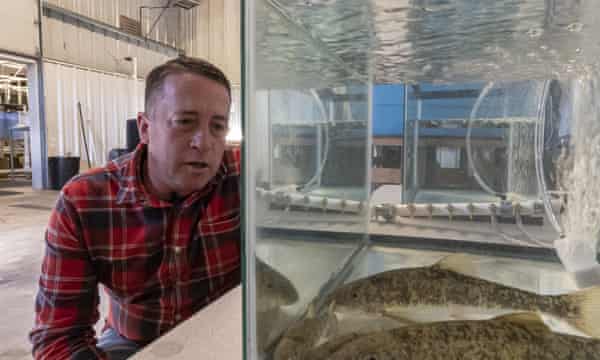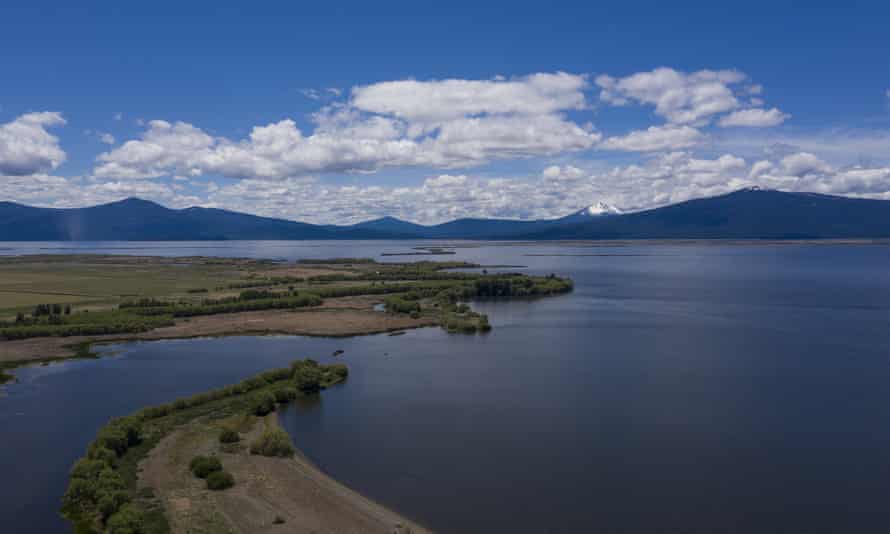Perry Chocktoot remembers the past time he ate a C’waam suckerfish. It was 1984. The fish was canned by a Klamath Tribes member and served with Tabasco. After ending off the meat, Chocktoot was still left with a tin of smoky fish oil mixed with sizzling sauce. “We just tipped it back and drank it,” Chocktoot recalled. “It was so great.”
Just 4 decades later on, the C’waam and its cousin the Koptu have been set on the endangered species listing. Given that then, for additional than 3 many years, no member of the Klamath Tribes has legally harvested the species, which are endemic to a lake and collection of rivers in southern Oregon recognised as the Klamath Basin and once shaped the spine to the tribes’ seasonal food stuff procedure.
The C’waam and Koptu are central figures in this summer’s combat for water in the Klamath Basin. They inhabit the exact same lake that farmers depend on to irrigate their crops. In May perhaps, amid a historic drought, the Bureau of Reclamation shut off water to somewhere around 1,200 farms to maintain a minimum amount lake depth for the suckers. In get to shield the suckerfish, the bureau is also keeping lake outflows to the Klamath River at a bare minimum, contributing to a die-off of juvenile coho salmon downstream in California.

But the energy to guard these suckerfish is not only about drought politics. It tells a generations-long story of how European food choices clashed with tribal food techniques and shaped what species we opt for to fish for, consume and secure in the western US.
In the Klamath Basin, exactly where periodic droughts expose fraught relations involving farmers and Indigenous peoples, these fish are also proxies for racism in the space, according to tribe members. “The fish are worthless and the tribes are worthless mainly because they care about the fish,” explained Don Gentry, the Klamath Tribes chairman, paraphrasing regional sentiments he has arrive throughout. “I can see that in folks’ minds.”
The C’waam and Koptu are challenging species that dwell for a long time – the oldest discovered C’waam was 57 years aged. The C’waam, the bigger of the two, is also acknowledged as the Misplaced River suckerfish, and the Koptu as the shortnose suckerfish. Equally have blunt heads and an earthy-gray coloration that fades into white bellies and massive protruding lips. They are not only a historical food items supply but part of the development story of the Klamath tribes.
Most of the fish spawn in the spring, migrating each and every calendar year from Upper Klamath Lake into a collection of tributary rivers to do so. They almost certainly numbered in the hundreds of thousands in the 1800s, and their spring migration would blanket riverbeds and signal the finish of winter season for the Modoc, Klamath and Yahooskin men and women – the 3 Klamath Tribes. In accordance to one particular account from 1883, the spawning activities have been so significant that a Modoc fisherman could simply catch 100 fish a day by plunging a spear into the water with a sharpened hook at the conclude.
Today, the C’waam and Koptu inhabitants has dwindled to an estimated 25,000 and 3,400 respectively. Lousy h2o excellent and the destruction of spawning habitat by decades of cattle grazing, dam making and water diversions have brought the species a long time away from extinction, claimed Alex Gonyaw, the Klamath Tribes’ senior biologist.
During summertime in the Higher Klamath Lake, corpses of 30-calendar year-old C’waam look on the lake’s floor – they hail from the previous profitable spherical of replica in the early 1990s. Latest h2o stages are only higher plenty of to maintain elderly fish on daily life aid, reported Gonyaw, and suckerfish larvae now never reach maturity. The lake’s current water amount is “the complete bare least to avert extinction”, he explained.
As C’waam and Koptu’s figures have dwindled, so has the graphic of these fish among the the community. The suckerfish were praised for their delicate flakey meat nicely into the 20th century, w
hich include by white anglers. A 1959 posting in the neighborhood Herald and Information newspaper, which referred to the suckerfish as mullet, noted that people traveled from throughout the region to purchase C’waam. A lot of “prefer the sweet meat of the mullet to any other fish”, the article claimed.

A long time later, having said that, the fish have morphed from an essential food items supply and endemic delicacy to a species derided by non-native people as a “trash fish” only suited for pet food items or the dumpster. One particular 2001 report in the New York Occasions described the C’waam and Koptu as “all-but-inedible”.
It is unclear when accurately that changeover took root. The 1959 Herald and News tale, although extolling the virtues of suckerfish, also pointed out there ended up no condition limitations on catching them for the reason that they were being considered a “trash fish”.
The C’waam and Koptu are not the only indigenous species to be considered rubbish. The phrase “trash fish” is a prevalent term that traditionally characterized a large set of substantial and boney species that were being usually prized by Indigenous peoples but experienced minor value to an overwhelmingly white and male activity-fishing inhabitants. Wildlife agencies officially refer to these fish as “rough fish”.
Attitudes versus “rough fish” identified a way into fish and wildlife management as perfectly. By 1962, perceptions of them had grown so hostile that wildlife administrators poisoned hundreds of miles of the Environmentally friendly River in an endeavor to destroy off razorback suckers and other indigenous species to clear the way for imported rainbow trout.
Even these days, implicit biases keep on to shape management devices for fish and wildlife, claimed Andrew Rypel, a foremost fish ecologist at the College of California, Davis. A current research Rypel co-authored discovered that common activity fish received 11 occasions a lot more exploration consideration in a lot of important tutorial journals than indigenous rough species.
Perry Chocktoot, the suckerfish fanatic, is the director for the Klamath Tribes’ lifestyle and heritage department and thinks the C’waam and Koptu’s name currently stems from a fundamental absence of know-how among the white fishers. “They didn’t check out us. They didn’t teach themselves on how to reduce these fish,” Chocktoot reported. The suckerfish, in contrast to trout, need to be filleted from the back, to stay away from popping the gallbladder, which spills yellow bile and ruins the flesh, Chocktoot discussed.
Each individual 12 months, Chocktoot oversees a ceremony in which a suckerfish is cremated. Prior to putting the fish in a hearth, Chocktoot delicately gets rid of the gallbladder, named the beese in Klamath language, and locations it in the roaring Sprague River. “One hundred and seventy several years, and they nonetheless never ever came and asked – how do you make them fantastic?” he reported. “They just set a label on them and stroll absent from them. Discredited them.”

In Klamath Basin, when water operates lower and suckerfish are saved alive at the price of farmers’ livelihoods, tribe associates say simmering racist attitudes bubble to the floor. Through the past key h2o shutoff in 2001, a few gentlemen drove into the tribal town of Chiloquin firing shotguns and yelling “sucker lovers”. Now the vitriol is mostly confined to social media and glares at nearby places to eat in the town of Klamath Falls, tribe users explained.
Gonyaw, the biologist, who is not a tribal member, said he believed that rhetoric surrounding the C’waam and Koptu displays typically unspoken sights about the Klamath Tribes. “They call them trash fish simply because they know they can not publicly discuss that way about the tribes,” he stated. “These fish are surrogates for how people truly feel about Native Us residents.”
Tracey Liskey, a fifth-technology Klamath Basin farmer, thinks small of the sucker fish – “They’re a real bony, yucky fish,” he claimed. “As far as the fish goes, there is no value to them in any respect.” Nonetheless, with his lover Don Barnes, Liskey is at the rear of 1 of the couple of present projects that could forestall the species’ extinction: excavated ponds loaded with human-reared suckerfish that will be introduced into the lake.
Liskey is aware of a frequently declining fish population usually means extra water limitations on farmers and he hopes to prevent their demise. “They’re in my h2o and they management my drinking water,” explained Liskey. “That’s my reason for currently being concerned in this matter.”
Some day the Klamath Tribes hope to harvest the C’waam and Koptu when once more – a right enshrined in their 1864 treaty with the US governing administration. If their drop can be reversed, rehabilitating the inhabitants will acquire decades. At 59 yrs old, Chocktoot happily shares recollections of scooping C’waam with Ritz crackers, but he might never eat a C’waam once again. “If their populace turned all over correct now, 50 several years from now they’d be huge adequate to try to eat,” explained Chocktoot. “I really do not have 109 decades.”